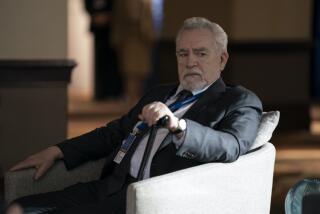Changing of the Guard Complete at Western Digital : Computers: New CEO Charles Haggerty takes over as the Irvine-based company faces a threat to its turnaround.
IRVINE — Charles Haggerty, president of Western Digital Corp. for the last year, on Tuesday became chairman and chief executive of the computer products firm, succeeding Roger W. Johnson, who was confirmed as head of the federal General Services Administration last week.
Haggerty, 51, takes over at a time of promise for the 23-year-old Irvine-based company, which has weathered its worst crisis in a decade and is now considered a technological leader.
At the same time, he faces another substantial challenge to Western Digital’s principal business: the sale and manufacture of computer disk drives, which store data on personal computers. A renewed price war among the five leading disk drive manufacturers could endanger the company’s financial turnaround.
Analysts say the company, as well as industry rivals such as Conner Peripherals Inc. and Maxtor Corp., could face losses for the next two quarters, though not as severe as during the previous price war of 1991. Western Digital has been profitable for the last four quarters, but before that it lost $212.7 million for the preceding six quarters.
“I have seen every indication that Chuck will be a very good leader for the company,” Johnson said.
While both Johnson and Haggerty balk at oversimplified comparisons of their management style, observers of the transition say there are obvious differences in the way the two men run the company.
“I give Roger credit for holding the company together through thick and thin,” said Phil Devin, an analyst at market researcher Dataquest Inc. in San Jose. “I give Chuck a lot of credit for coming and being the tough guy. Western Digital needed a kick in the pants.”
To cope with a series of disasters, including the national recession and a severe industrywide price war, Johnson over the last two years has restructured the company, renegotiated loan agreements and brought in a new crop of executives, including Haggerty.
“Their styles are very different,” Devin said. “Roger was a visionary and somewhat of a dreamer. He wasn’t as concerned with day-to-day control of inventory, cash and such things.”
Johnson, who engineered the corporation’s second financial recovery in a decade, said such a comparison is a broad generalization.
“I think it’s unfair and not useful to compare styles. . . . Everything changes so fast in this industry that even within a year, different kinds of leadership are needed from the CEO,” he said. “Sometimes you have to be a visionary, a taskmaster and terribly pragmatic.”
For his part, Haggerty said: “It’s not a dramatic transition by any means. Roger and I have shifted responsibilities over the last year, and he allowed me to pick up things at my own speed.
“I will talk to all the employees in large meetings over the next several months and to all the major customers and suppliers too,” he said. “But the only ceremony will be to come to work in the morning and to get on with it.”
But Haggerty said it is fair to say that he is more conservative and more operations-oriented in his business style than Johnson was in recent years.
Haggerty draws his lessons from decades of training at International Business Machines during its heyday. He started at the computer giant as a clerk in 1964. As he climbed the corporate ladder over a 28-year period, he was involved in some of Big Blue’s most entrepreneurial businesses. He was manager of the Boca Raton, Fla., plant where IBM launched its PC business in 1981. He also managed storage operations for IBM and launched its highly successful AS/400 minicomputer system for medium-size businesses from 1987 to 1989.
While Johnson’s dry wit, charismatic personality and activism in politics and high-society charity efforts often held center stage, Haggerty said he is focused on making Western Digital the center of attention.
Most of Johnson’s management team remains intact, although Haggerty in February hired Travis A. White, former president of LSI Logic Corp.’s Canadian subsidiary, to head the company’s unprofitable computer chip manufacturing business.
“I will allow people to run their businesses,” he said. “They will be responsible for them and accountable for them.”
Haggerty said the company has regained its standing among the major industry computer makers that it supplies, such as IBM, Apple, Compaq and AST--all of which are ordering more components than in the past.
Industry analysts said they are surprised to see Western Digital, once slow in introducing products, take the forefront in bringing new disk drives to market. The company was the first to introduce disk drives with capacities of 170 megabytes and 340 megabytes of storage. (One megabyte stores 500 single-spaced typewritten pages of data.)
“We are suffering from the same price problems, but the patient is not critical like it was two years ago,” Haggerty said.
He intends to focus the work force on quality, achieving technological superiority and profits. But he does not expect drastic changes in employment or in the company’s strategic direction.
“The company grew up in an age where the market would take anything you made because it was all new,” he said. “Now we have to distinguish ourselves and convince the market that our product is worth buying.”
One immediate goal is to reduce Western Digital’s dependence on disk drive sales, which account for 85% of its revenue, compared to about 65% two years ago.
The company may also delve further into marketing to others its know-how in areas such as the import-export business.






